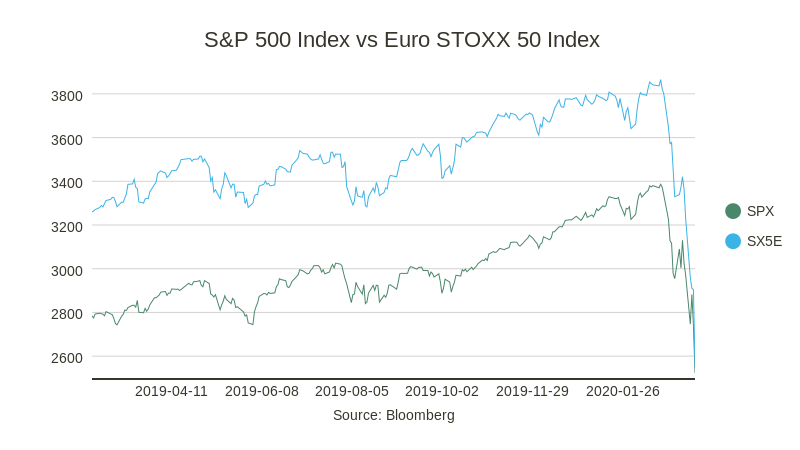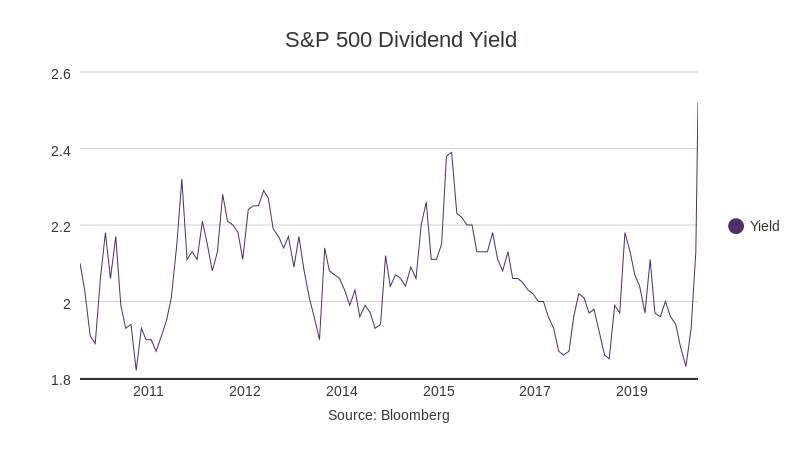February saw world stock markets head rapidly into reverse after it became clear that the coronavirus had spread outside of China.
The first 10 days of March have seen another jump in volatility and sharp falls in stock prices in all the leading markets - see chart, right.
US stocks are now around 20% off their January peaks and into heavily oversold territory. The EURO STOXX 50 has fared even worse, as have the Japanese and UK markets.
This week stock markets have fallen particularly sharply as a collapse in the oil price added to the virus woes, knocking out a number of significant levels on the way: 3000 for the S&P 500, 6000 for the FTSE 100 (the first time since 2016).
Coronavirus, or COVID-19, is clearly a virulent virus and capable of rapid transmission. But the pattern of infection from viruses is reasonably well understood, increasing for about a month following detection then tailing-off over subsequent weeks.
The outbreak in Hubei Province commenced in January and increased rapidly to a mid-February peak, and has since been decreasing. With the strict containment measures imposed, the rest of China peaked earlier in February at significantly lower levels of infection and has been declining ever since.
Cases elsewhere, notably in Italy, commenced sometime around mid-February and are still on the increase – but it would be odd if they did not conform to pattern. Undoubtedly, this will vary with each country’s response and it will get worse in the West before getting better – but it will end.
Governments start taking measures
The question is how much of a hit to economic growth will be sustained. The first half of 2020 will, of course, see significantly lower growth around the world, but we are beginning to see counter-measures from governments and central banks so the second half of the year is less clear.
Cutting already low interest rates to even lower or negative levels is of limited use, what is required is a targeted response from governments involving actual cash or tax relief measures to those particularly affected.
We have also seen something of a stampede into government bonds as a ‘safe haven’, which has pushed yields to record lows again and raising fears of recession. In the UK, the two-year gilt yield is struggling to remain positive.
This slump in government bond yields seems to me to owe as much to the thin/illiquid nature of current markets – thanks to central bank and regulatory actions – as it does to a rational economic assessment.
Meanwhile, I would question whether anyone with a time horizon of more than a few weeks would sensibly buy a 30-year UK gilt with a yield (fixed) of 0.4% rather than Unilever with a yield (probably growing) of 4%, or a 30-year US Treasury on a 1% yield as opposed to JP Morgan, Johnson& Johnson, Coca-Cola, McDonalds.
Oil prices also plunge
The collapse in the oil price is a direct response to the breakdown of talks between Saudi-led OPEC and Russia. The latter refused to go along with an OPEC plan to cut production so the Saudis have turned rough and increased production.
The US shale oil industry will not be at all happy (which was likely part of the plan). I should quietly mention that falling oil prices help the rest of the World.
We have been observing for a number of months how some stock markets were getting expensive, notably the US market, this is now contributing to the sell-off. See right for a simple chart of the dividend yield on the S&P 500, which illustrates our point.
As the scope of the impact this virus will have on markets remains to yet be seen, this sort of commentary can easily be made to look foolish in the febrile climate that we face. I must stress that short-term moves are liable to some serious mood swings. So, while there does appear to be some good value appearing in markets, it really is not possible to say that prices won’t get cheaper yet.
How would you like to share this?



